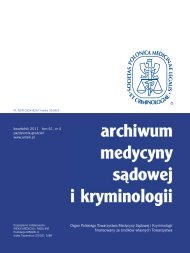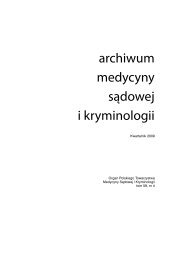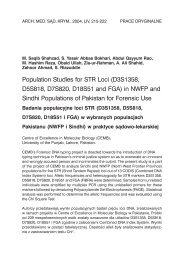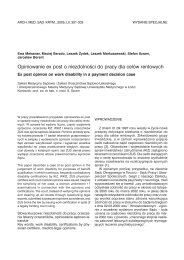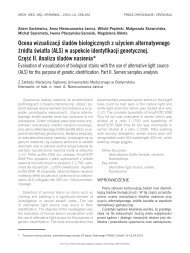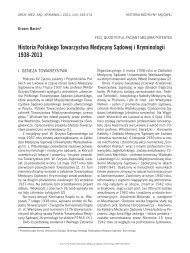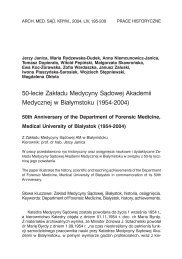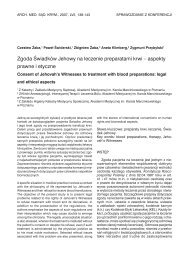PeÅny numer do pobrania (*.pdf) - Archiwum Medycyny SÄ dowej i ...
PeÅny numer do pobrania (*.pdf) - Archiwum Medycyny SÄ dowej i ...
PeÅny numer do pobrania (*.pdf) - Archiwum Medycyny SÄ dowej i ...
Create successful ePaper yourself
Turn your PDF publications into a flip-book with our unique Google optimized e-Paper software.
ARCH. MED. SĄD. KRYMINOL., 2012, LXII, 104-108<br />
ORIGINAL PAPERS<br />
Analysis of the impact of external factors on the occurrence<br />
of morphological lesions in cases of death from hypothermia<br />
The objective of this study was to determine the<br />
prevalence of macroscopic morphological lesions<br />
typical of death from hypothermia and to show their<br />
correlation with such factors as blood alcohol level,<br />
air temperature, age and number of layers of clothing.<br />
The analysis was performed based on protocols<br />
of autopsies performed in the years 1995-<br />
2009. The sample comprised 124 persons with a<br />
diagnosis of death from hypothermia. The results<br />
showed no correlation between the number of gastric<br />
erosions and the level of alcohol in blood or<br />
urine. However, an association was demonstrated<br />
between the presence of erosions and the number<br />
of layers of clothing. A positive correlation may<br />
indicate an increased sensation of cold by such persons<br />
and the resultant more intense vascular constriction<br />
response occurring in the gastric mucosa.<br />
Key words:<br />
hypothermia, gastric erosions<br />
INTRODUCTION<br />
A human being is assumed to be in the hypothermic<br />
state when his internal temperature is<br />
below 35°C. Death from hypothermia <strong>do</strong>es not necessarily<br />
occur at out<strong>do</strong>or temperature below 0°C,<br />
but also at temperature above 8°C if the individual<br />
in question is susceptible. The degree of sensitivity<br />
to low temperature is an individual trait. Infants and<br />
the elderly are particularly susceptible to hypothermia.<br />
This is also true in case of individuals presenting<br />
with consciousness disturbances following<br />
alcohol or narcotics abuse or after a cranio-cerebral<br />
injury. Typical macroscopic morphological lesions<br />
observed in post-mortem examinations are frostbites<br />
resulting from microcirculation disturbances<br />
evoked by very low temperatures, usually occurring<br />
at below 0°C range. Gastric mucosa demonstrates<br />
acute hemorrhagic erosions associated with the effect<br />
of a stress-inducing factor (cold), which affect<br />
the hormonal balance of the body. Ecchymoses in<br />
the ilio-psoas muscle are a quite characteristic feature,<br />
yet they occur rarely [1, 2, 3, 11].<br />
OBJECTIVE<br />
To determine a correlation between the number<br />
of erosions in the gastric mucosa and factors observed<br />
in cases of death from hypothermia that<br />
may affect the occurrence of hemorrhagic erosions<br />
in the stomach. To interpret the incidence of such<br />
lesions in view of their usefulness in medico-legal<br />
practice in determining hypothermia-related cause<br />
of death.<br />
MATERIAL AND METHOD<br />
The statistical analysis was carried out based<br />
on data originating from protocols of autopsies<br />
performed at Chair and Department of Forensic<br />
Medicine, Jagiellonian University Medical College,<br />
in the years 1995-2009. The authors selected and<br />
evaluated autopsy protocols of 124 individuals with<br />
final diagnoses of death from hypothermia. The<br />
diagnosis was based on the presence of morphological<br />
lesions typical of death from hypothermia<br />
observed in individuals who died at low ambient<br />
temperatures, or (usually with a lower degree of<br />
positivity) – on cases of deaths at low ambient temperatures<br />
with a concomitant absence of organ-involving<br />
lesions that might explain death by a<br />
disease process or an injury. The analyzed database<br />
included statistically serialized cases of death involving<br />
22 females and 102 males. The analysis<br />
was performed by the Statistica 8.0 software using<br />
the following tabs: correlation matrices, multiple regression<br />
and non-parametric statistics.<br />
RESULTS<br />
While processing the database, the authors used<br />
data from autopsy protocols referring to the number<br />
of gastric erosions, which were described by postmortem<br />
examination-performing physicians by such<br />
terms as ”a small number”, ”<strong>numer</strong>ous”, ”multiple”,<br />
etc. These categories were translated into relevant<br />
<strong>numer</strong>ical values (none – 0; a small number – 1;<br />
<strong>numer</strong>ous or multiple – 2; a high number – 3) to be<br />
2012 © by Polskie Towarzystwo <strong>Medycyny</strong> Są<strong>do</strong>wej i Kryminologii, ISSN 0324-8267



